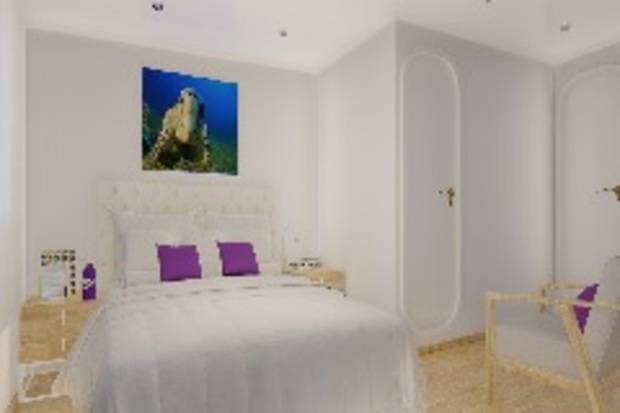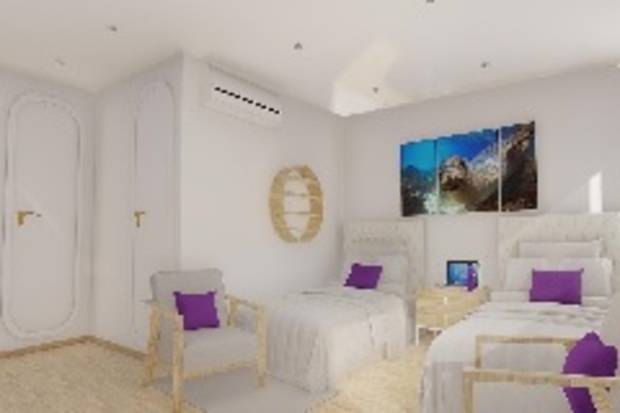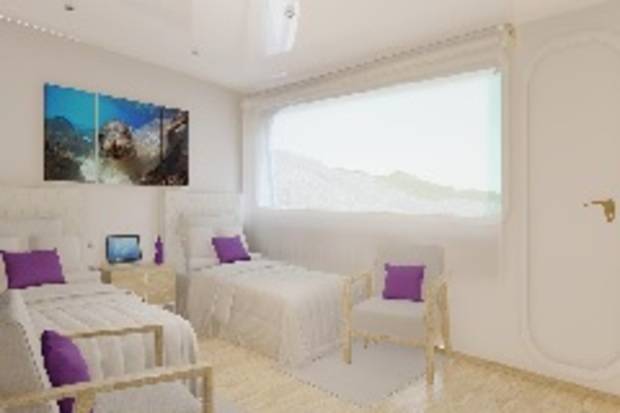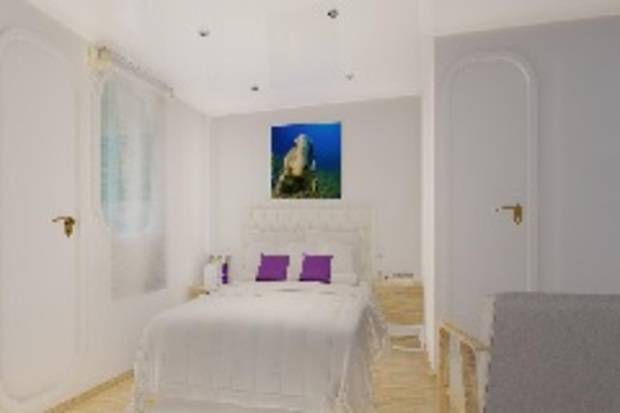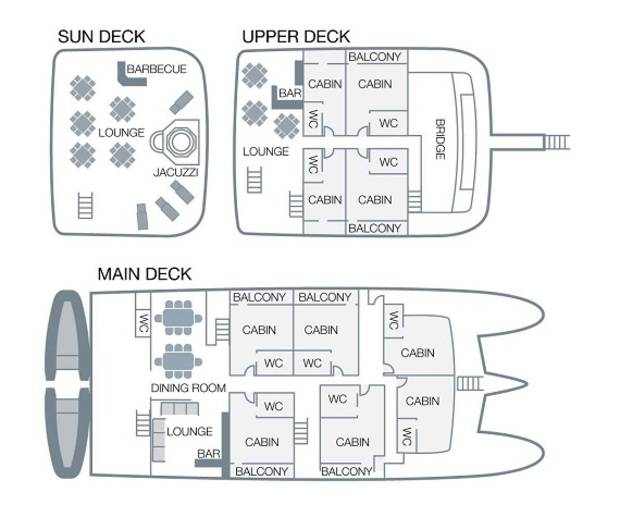Central & East Islands
10 Days - Reina Silvia Voyager
Venture to the Galapagos Islands, teeming with an incredible diversity of marine and animal life as you explore the central and eastern islands of the archipelago. The new Reina Silvia Voyager will transport you to some of the most beautiful and exciting locations where you will have the chance to spot marine life, witness the famous giant tortoises of Santa Cruz and hike along the red sand beach of Rabida Island.

Home » 10 Day Reina Silvia Voyager: Central & East Islands
Itinerary Highlights
- Cruise on one of the newest catamarans in the archipelago
- Witness the giant tortoises of Santa Cruz
- Spot marine life, including three types of boobies, on the volcanic landscapes of Punta Pitt
- Hike along a saltwater lagoon on Rabida Island
Itinerary in Brief
- Day 1: Arrive in Quito
- Day 2: Fly to the Galapagos Islands
- Day 3: Espanola: Gardner Bay & Punta Suarez
- Day 4: San Cristobal: Isla Loboa & Punta Pitt
- Day 5: Santa Fe & South Plaza
- Day 6: Genovesa: Darwin Bay & El Barranco
- Day 7: Santiago & Bartolome
- Day 8: Rabida & Chinese Hat
- Day 9: Return to Quito
- Day 10: Depart Quito
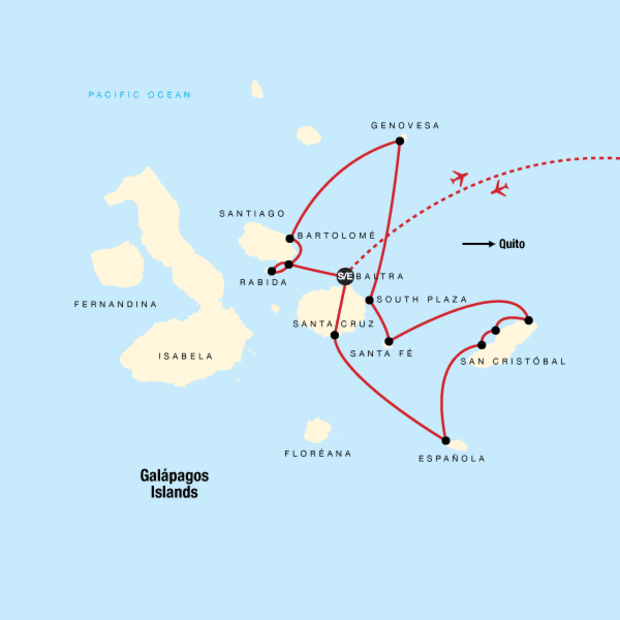
Day 1: Arrive in Quito
Arrive at anytime. Arrival transfer included.
There are no planned activities, so check into the hotel and enjoy the city. A G Adventures representative will greet you at the hotel and brief the group on the various aspects of the tour.
Day 2: Fly to the Galapagos Islands
Transfer early to the airport for the flight to the Galápagos Islands. Upon arrival, meet the Naturalist Guide and cross to Santa Cruz islands to visit the highlands and the Charles Darwin Research Station before boarding the boat in the late afternoon from Puerto Ayora.
After arrival in Baltra, visit of the highlands of Santa Cruz Island for a special opportunity to view the islands’ most famous reptile: the giant tortoises in their wild habitat. What a privilege to see an endangered species roving in this lush environment! The vegetation of the area includes the Scalesia Forest (an endemic giant daisy tree) and birds such as the vermilion flycatcher will delight everyone with its scarlet feathers against an emerald green forest. Look for Darwin’s finches, particularly the famous Woodpecker Finch. We will then visit the Fausto Llerena Breeding Center and Charles Darwin Research Station to learn first hand of the conservation and research efforts in the islands. There, you’ll see several subspecies of adult tortoises, lots of hatchlings, and learn of the repatriation programs that are saving several subspecies of tortoises and iguanas from extinction.
Day 3: Espanola: Gardner Bay & Punta Suarez
Spend part of the day visiting spectacular Gardner Bay. Walk across a lovely white sand beach amongst a busy sea lion colony and nesting sea turtles (seasonal). Later, take some time exploring the Punta Suárez visitor site, on the north-western corner of the island. Here, birds are everywhere—underfoot, on the trail, overhead, diving into the sea, taking off from cliffs, sitting quietly, and if the timing is right, engaging in ritual mating dances or hatching eggs. As the panga driver guides us in through the surf to the landing, sea lions are often seen “hanging 10” on the waves. A great tangle of marine iguanas, stretched out in the sun on the beach, are usually present when we arrive.
Day 4: San Cristobal: Isla Lobos & Punta Pitt
Start the day with an early navigation around the spectacular Kicker Rock. This striking rock formation is located a couple hours off the western shore of San Cristobal. Jutting out of the water, the rocks stand vertically at hundreds of feet above the ocean divided by a small channel. Head to Lobos Island, the most easterly point in the archipelago is one of only a few visiting sites in Galapagos where red-footed boobies can be observed. All three boobies (blue-footed, red-footed and Nazca) are known to nest here, and at Islote Pitt which is a small islet near the anchorage. Blue-footed boobies can often be seen plunge-diving for fish while frigate birds soar overhead. The trail at Punta Pitt winds up through eroded volcanic tuff formations to a plateau for a spectacular view of the island, and Islote Pitt. Along the trail are endemic plants and wildlife unique to San Cristobal, such as the San Cristobal mockingbird and the San Cristobal lava lizard.
Day 5: Santa Fe & South Plaza
Today, spend time visiting fascinating Santa Fé, home to a small population of very large land iguanas, and the largest of the Opuntia cacti. The lagoon is ideal for swimming and snorkeling; sea lions and colorful fish are in abundance here, as well as the occasional sea turtle. Later, visit South Plaza, a small, but very rewarding island to visit. Here you see an array of endemic land iguanas munching on Opuntia blossoms and leaves. On the upper edge, at the windward side, Swallow Tailed Gulls nest. Watch these beautiful birds maneuver in the tricky air currents as they set up to land on the cliff face. From the bluff you can see schools of Yellowtail Mullet, occasionally a shark, and lots of birds flying back and forth.
Day 6: Genovesa: Darwin Bay & El Barranco
In the morning, visit the white-sand coral beach of Darwin Bay which winds through mangroves filled with land and marine birds. See Nazca boobies, red-footed boobies and swallow-tailed gulls, and further down the path, observe tidal pools where sea lions swim playfully. In the afternoon, visit El Barranco (also known as Prince Phillip’s Steps), which is a steep, rocky path that leads up to a high cliff-face. If you’re lucky, catch a glimpse of red-footed boobies, short-eared owls, Nazca Boobies, storm petrels, Galapagos swallows, and Galapagos doves, as you enjoy this magnificent views.
Day 7: Santiago & Bartolome
The morning visit heads to Sullivan Bay on Santiago Island, located on the southeast part of the island. This place is interesting for its geology because the area has elevations in form of small volcanoes, formed by the lava flows. Later, head to Bartolomé Island, home of the famous Pinnacle Rock. This is an exceptional place to observe volcanic island geology and to snorkel. Among the many colorful species you will see Bi-color Parrotfish, Streamer Hogfish, and Flag Cabrilla. Sometimes you get a special treat—a penguin “snorkeling” right around you in hunt of fishy treats. The long climb up the wooden steps to the pinnacle of this cinder cone takes you through cinders and rough volcanic formations, a veritable moonscape. The lower slopes are graced with a light sprinkling of the delicate, silvery Taquilia, a ground hugging plant adapted to this harsh spot. On top you will enjoy the spectacular view of Bartolomé, Santiago, and several other nearby islands.
Day 8: Rabida & Chinese Hat
Rabida is a “small red island,” the colour of the volcanic cinders.The red beach is usually well populated with sea lions and pups. At times the low salt bushes are loaded with nesting California Brown Pelicans. Just behind the beach, in a brackish lagoon, see Bahamas White-cheeked Pintail Ducks, migratory shore and wading birds, and Greater Flamingos. Flamingos need the presence of a dozen or two other flamingos to stimulate their synchronous mating dance. If our timing is right, we will be able to observe this highly entertaining ritual as well as two species of boobies nest along the cliffs. Later, travel to Sombrero Chino, a tiny island just off the southeast tip of Santiago. Its name (Chinese Hat) describes the island’s shape. Though centrally located, it is one of the least visited sites in the area. Patches of pahoehoe lava, cracked lava and lava tubes can be found on the island. If you’re up for a walk, a path leads to some spectacular views of the waves crashing below. White-tipped sharks frequent the area, as do the playful Galapagos Penguins and sea lions.
Day 9: Fly back to Quito
Disembark the boat at Baltra to transfer to the airport and catch the flight back to Quito. Upon arrival, transfer to the hotel and joy one final night on the town.
Day 10: Depart Quito
Depart at any time.
Whats included?
- Internal flights between Quito and the Galapagos Islands
- Pre-cruise accommodation in Quito for 1 night
- Post-cruise accommodation in Quito for 1 night
- Transfer from hotel to airport in Quito on day 2
- On-board accommodation
- Meals: 9 breakfasts, 7 lunches, 7 dinners
- All landings and excursions
- Snorkelling equipment and wetsuits
What’s not included?
- Air transportation other than flights specified
- Passport, visa and immigration fees
- Airport taxes
- Additional hotel nights
- Travel protection plan
- Alcoholic & non-alcoholic beverages
- Laundry service
- Gratuities
- Any items not mentioned as included









